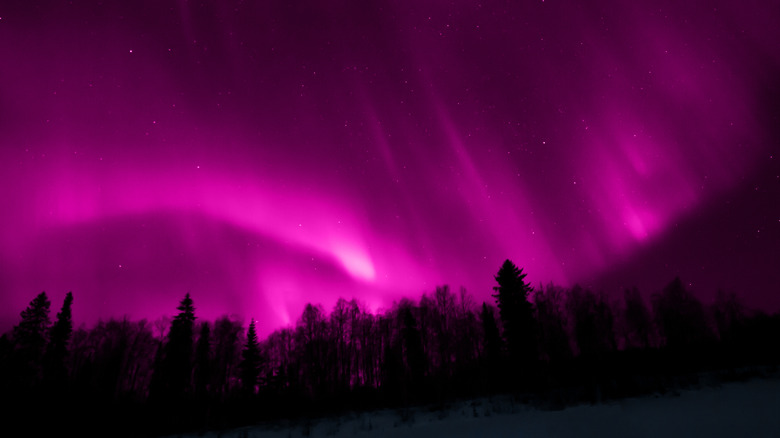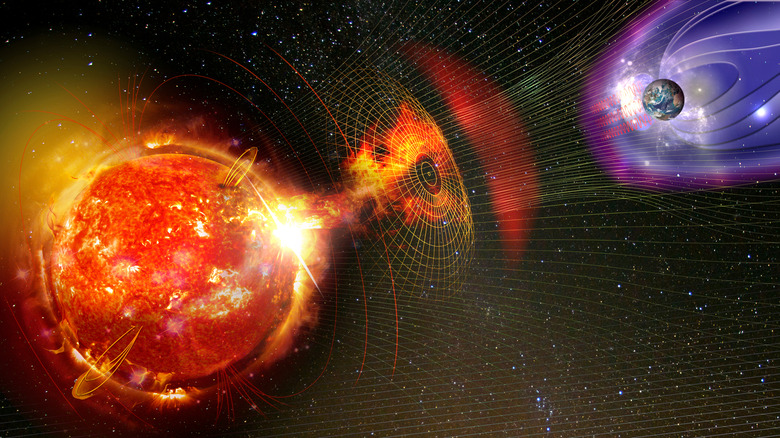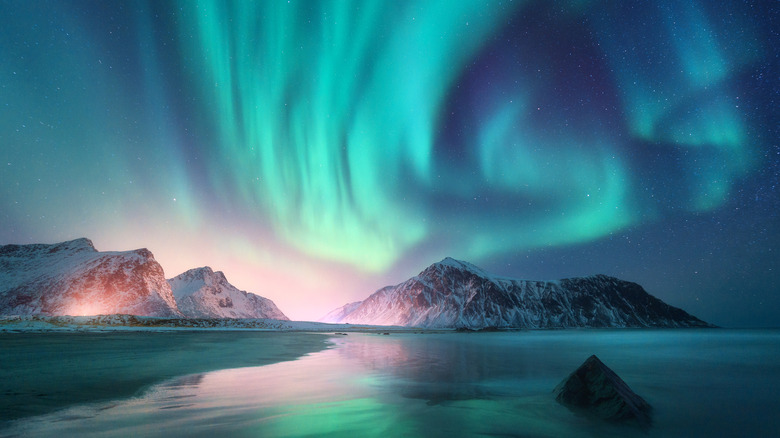A Hole In The Planet's Magnetic Field Caused A Rare Pink Aurora Over Norway
The northern lights, also known as the aurora borealis, are beloved by both scientists and casual viewers alike (via Space.com). It's believed that famed astronomer Galileo Galilei is the one who came up with the name "aurora borealis." However, aurora borealis is a term that is used for North Pole phenomena only. At the South Pole, this event is referred to as aurora australis (per the Deseret News). As The Old Farmer's Almanac explains, these auroras create a colorful display that glows in the night sky. These colors can include green, blue, purple, red, and yes, even pink.
According to Live Science, pink is seldom seen in aurora light shows. But in early November 2022, Markus Varik, a tour guide for the Norwegian-based Greenlander tour company, was lucky enough to see and digitally capture the pink auroras (via Twitter). He told the publication, "These were the strongest pink auroras I have seen in more than a decade of leading tours." He added, "It was a humbling experience." Varik was bewildered by the pink auroras and went on to say (via SpaceWeather.com), "I thought I had seen it all." He explained, "The pink color was bright and obvious to the naked eye. My entire group was stunned."
The pink auroras were formed by a crack in the earth's magnetic field
NASA explains that auroras are caused by the sun, which sends energy and other particles to Earth. The Earth's magnetic field usually protects the planet from this. However, this is not completely foolproof. Sometimes, solar storms may occur that send electrified gas and particles toward Earth at high speed. These can meet at the magnetic field lines at both the North and South Poles, and the outcome of this impact is colorful auroras. IFLScience reports that the pink auroras were also the aftermath of a solar storm. Ultimately, this storm caused a hole in the Earth's magnetic field.
In this case, Live Science states that the electrified particles traveled so fast that they were able to get deeper into the atmosphere, resulting in the beautiful pink auroras. According to SpaceWeather.com, the conditions that caused the pink auroras were labeled a G1-class geomagnetic storm. In simple terms, it's harmless but leads to the formation of the aurora lights. Furthermore, this phenomenon happens to occur at the North and South Poles because the Earth's magnetic field tends to be weaker at these locations. Nevertheless, NASA notes that auroras can and do happen on other planets, including Saturn and Jupiter.
The pink auroras are produced by nitrogen
According to Live Science, green is often the color associated with auroras. The publication explains that this is due to oxygen particles, which can commonly be found where solar particles reach the atmosphere. SpaceWeather.com notes that this is 100 km to 300 km (or 62 to 186 miles) above the Earth's surface. But as previously mentioned, the auroras can be various hues like blue, purple, and red (via The Old Farmer's Almanac). Per the Government of Canada, the colors depend on different components. This includes altitude, the atmosphere's density, the gasses in the atmosphere, and the amount of energy. For example, red is also caused by oxygen particles.
However, the collision between the solar and oxygen particles occurs at a higher altitude, resulting in the red tint. NASA reports that nitrogen causes the auroras to turn blue or purple. The Government of Canada adds that hydrogen and helium can also produce these colors. As for the colors pink and dark red, nitrogen is to blame. During the G1-class geomagnetic storm, SpaceWeather.com writes that the solar and nitrogen molecules smashed into each other below 100 km (62 miles). Thus, Live Science states that the auroras turned a glowing shade of pink.


